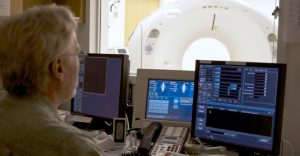Anyone who spends much time in hospitals is used to hearing a lot of initials. While some of the more technical terms can sound like a foreign language, by now most of us are familiar with terms like MRI (Magnetic Resonance Imaging), EKG (electrocardiogram), and CT Scan (Computed Tomography). But for Grays Harbor residents, having access to the equipment those initials represent means the difference between being treated in their own backyard and driving to Olympia or Seattle for a diagnosis.

Such tools fall into the category of diagnostic imaging, a way for doctors to see through bone, tissue and organs and gather information. “Patients benefit because they can get a diagnosis of what’s going on with their bodies,” says John Simon, Director of Diagnostic Imaging at Grays Harbor Community Hospital. “We have most everything here so the community may not have to go to Olympia for their imaging needs.”
Different equipment serves different functions at the facility, all of which enables the medical staff to diagnose and treat a multitude of ailments without the need for more complicated procedures. “They all have their niche in the market,” says Simon. “X-rays are good for looking at bones, and ultrasound is very good for looking at soft tissue or things that have fluid in them.”
“It’s composed of wave forms, sort of like radar,” says Simon. “Ultrasound is very good at imaging for pregnancies, because there is no radiation.”

Although ultrasounds are commonly associated with pregnancy and women’s health, they can also be used to create images of the abdominal and pelvic organs, muscles and tendons, and heart and blood vessels with anyone.
CT works differently; Simon likens it to ‘computerized slices of bread.’ “It radiographically takes different slices and thicknesses of your body,” he says. CT scans produce computerized combinations of many different x-ray images taken from different angles. The resulting cross-sectional or tomographic image allows medical personnel to ‘see’ inside without the need to be invasive. The scans are useful for getting clear images of soft tissues, blood vessels, the brain, bones, and more.
Women’s health is covered by both mammograms and DEXA (dual-energy x-ray absorptiometry) scans, which measure bone density. “Osteoporosis is more prevalent in women,” says Simon. “As we age, our bones lose calcium and become more brittle. DEXA scans help to determine the medication to strengthen bones and or, activities that need to be limited.”
To look at internal organs, the hospital uses nuclear medicine, a method that uses small amounts of radioactive material to diagnose diseases ranging from various types of cancer to heart disease, gastrointestinal disorders, endocrine issues, and neurological problems.
“It’s an effective way to look at the functionality of your organs,” says Simon. “The highly trained staff inject you with technetium, which is a radioactive isotope, and look at the functionality of your stomach and digestive tract, for example. A camera records all of the information as your body is emitting certain electrons and a computer tracks how things look and move through your body.”

Although MRIs have been around since the 1970’s, Simon believes that their potential has yet to be fully tapped. “The technology is still in its infancy as far as what we can do with it,” he says. “It can diagnose for Alzheimer’s and look for strokes.” MRIs use a combination of radio waves, magnetic fields, and field gradients to create images of organs and tissues. “They’re great for finding issues with joint spaces, tumors, bleeding, infection, arthritis, and spinal stenosis,” says Simon.
Over time, the level of detail MRIs can reveal has gotten much more exact. That’s because of their Tesla levels, a term for a unit of measurement for the strength of magnetic fields. Currently, the standard is 1.5 Tesla (T), says Simon. Additionally, newer machines are shorter and wider than they were in the past, which helps to alleviate claustrophobia that some patients experience during the procedure.
MRIs are commonly used to diagnose sports injuries such as ligament and cartilage damage, but are also helpful in identifying spinal conditions, vascular abnormalities, musculoskeletal problems and neurological issues such as dementia.
Currently, the hospital’s MRI machine is located at Grays Harbor Imaging, just up the road from the main campus of the hospital. And for our patient’s convenience, their hours of operation are from 7:00 a.m. to 7:00 p.m. In the very near future, a new 1.5 T short bore 70cm diameter MRI machine will exist on the main campus. “We have a place to put an MRI unit,” says Simon. “Now we’re looking for a vendor. That will allow us to serve our population better.”
At Grays Harbor Community Hospital, expanding their diagnostic imaging services is just one of the many ways they are fulfilling their mantra of ‘Quality Care Close to Home.’
For more information about Grays Harbor Community Hospital, visit www.ghcares.org.
Sponsored











































